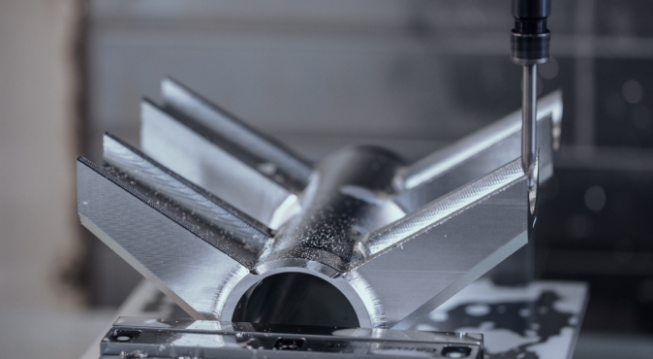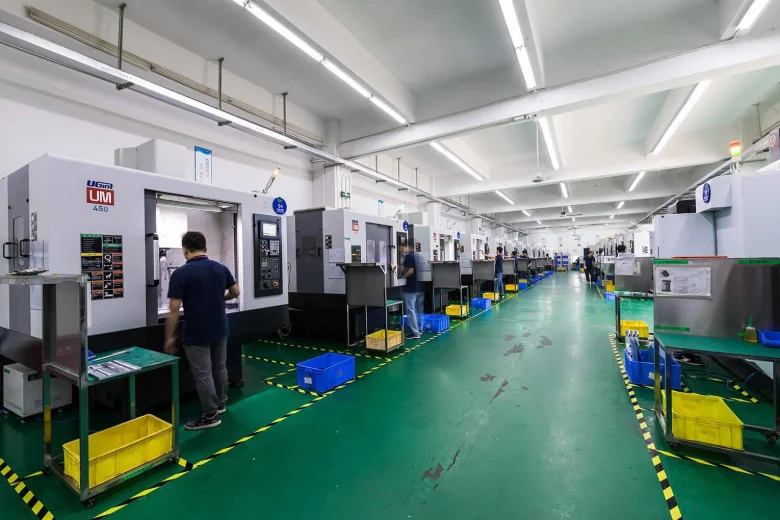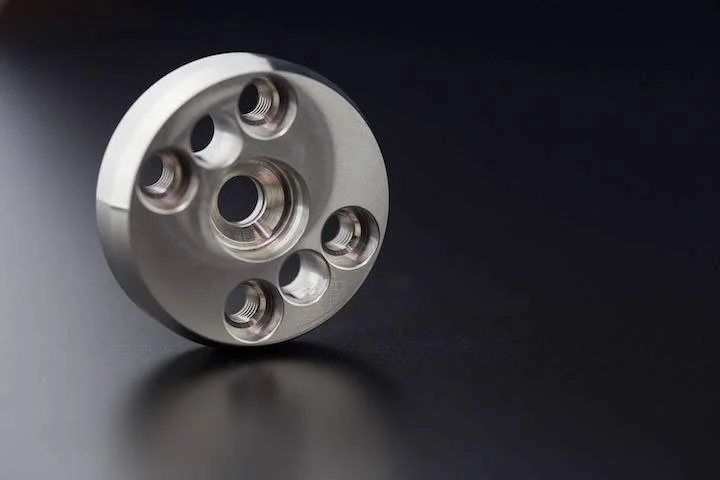Titanium is available in different grades, including commercially pure titanium (>99% Ti) (Grades 1 to 4) and titanium alloys (Grades 5 and higher). In the table below, you’ll find a description of these grades, their properties, and applications. This information can help you choose the right material for your titanium part design.
Table 1: Common Titanium Grades Used for CNC Machining
Grade Description Properties Applications Grade 1 Commercially pure
Low oxygen contentExcellent corrosion resistance
High impact toughness
Easy to CNC machine
Not as strong as some other titanium gradesChemical processing
Heat exchangers
Desalination
Automotive parts
Airframes
Medical Grade 2 Commercially pure
Standard oxygen contentStronger than Grade 1
High corrosion resistance
Good ductility
High formability, weldability, and machinabilityAirframes and aircraft engines
Hydrocarbon processing
Marine
Medical
Chlorate manufacturing Grade 3 Commercially pure
Medium oxygen contentMore difficult to form than Grades 1 and 2
High strength and corrosion resistance
Decent machinability Aerospace
Marine
MedicalGrade 4 Commercially pure
High oxygen contentHighest strength among the pure grades
Excellent corrosion resistance
Requires high feed rates, slow speeds, and high coolant flow
Difficult to machineCryogenic vessels
Heat exchangers
Hydraulics
Airframes and aircraft engines
CPI equipment
Marine
Surgical hardwareGrade 5 Titanium alloy
Ti6Al4VHigh corrosion resistance
Excellent formability
Poor machinabilityAirframe structures and aircraft engines
Power generation
Medical devices
Marine and offshore
HydraulicsGrade 6 Titanium alloy
Ti5Al-2.5SnGood weldability
Stability and strength at high temperatures.
Intermediate strength for titanium alloysLiquid gas and propellant containment for rockets
Airframe and jet engine applications
Space vehiclesGrade 7 Sometimes considered pure, but contains small amounts of palladium
Ti-0.15PdSuperior corrosion resistance
Excellent weldability and formability
Lower strength than other titanium alloysProduction equipment parts
Chemical processingGrade 11 Sometimes considered pure, but contains small amounts of palladium
Ti-0.15PdExcellent corrosion resistance, ductility, and formability
Even lower strength than Grade 7 alloysDesalination
Marine
Chlorate manufacturingGrade 12 Titanium alloy
Ti0.3Mo0.8NiHigh strength at high temperatures
Great weldability and corrosion resistance.
More expensive than other titanium alloysHydrometallurgical applications
Aircraft and marine components
Heat exchangers.Grade 23 Titanium alloy
T6Al4V-ELIGreat formability and ductility
Fair fracture toughness
Ideal biocompatibility
Poor machinability
Lower strength than other titanium alloysOrthodontic appliances
Orthopedic pins and screws
Surgical staples
Orthopedic cables

CNC machining supports design complexity, but titanium poses special challenges.
Titanium can be machined with CNC milling, turning and lathing, drilling and boring, utilizing a multi-axis precision machine. Each process involves different operations and has benefits and challenges.
Milling uses rotating tools to shape parts and requires managing speeds and coolant levels to prevent tool wear.
Turning and lathing rotate the titanium workpiece while a stationary tool shapes it. It’s ideal for cylindrical parts but requires careful handling to avoid excessive vibrations and ensure a smooth finish.
Drilling and boring are two similar processes. Drilling creates precise holes using sharp bits. Boring enlarges these holes and is used to meet tight tolerances.
5-axis machining is the most advanced process, allowing the titanium workpiece to move along five different axes. Because it can create intricate parts with fewer setups, it’s particularly useful in aerospace and medical applications.
Looking ahead, emerging technologies such as AI-driven toolpath optimization and smart machining systems are expected to revolutionize CNC machining. Additionally, the use of hybrid manufacturing—combining additive and subtractive methods—is expected to provide greater design flexibility.

Fictiv uses high-precision CNC machining equipment to produce parts at amazing speeds.
Regardless of the CNC machining equipment you use, it’s important to fine-tune your machining parameters to achieve high-quality results. Cutting speeds and feed rates, machining tolerances, and coolant are important considerations.
Careful control of cutting speeds and feed rates help prevent workpiece overheating and tool wear. Lower cutting speeds paired with higher feed rates reduce heat buildup and maintain the integrity of the tool and the workpiece. If higher speeds are required, cutting tools coated with titanium aluminum nitride (TiAlN) or titanium carbo-nitride (TiCN) are recommended.
When CNC milling titanium, the ideal cutting speed varies depending on the specific type and grade of titanium, as well as the tooling and coolant used. A general guideline is a surface speed of approximately 60-100 feet per minute (FPM) or 18-30 meters per minute (MPM). It’s crucial to also consider other factors such as feed rate, depth of cut, and the machine’s power and rigidity.
It’s difficult to achieve tight tolerances with titanium because of the metal’s sensitivity to heat and tendency to cause tool deflection. However, you can prevent excessive deflection by ensuring that parts are well-supported and secured. Shorter cutting tools also reduce deflection, while a well-stabilized setup minimizes vibrations that affect machining accuracy.
Temperature control is critical when machining titanium. Directing a steady, high-pressure stream of coolant at the cut region cools both the workpiece and the cutting tool. A high-pressure coolant stream also removes chips that would otherwise stick to the tool. Adjust the volume and concentration of coolant to optimize usage and avoid waste.
To mitigate heat build-up, use a coolant with excellent lubricity and cooling properties. Coolants specifically designed for machining difficult materials, such as emulsion-based coolants with high lubricity, are recommended.
Preventing overheating involves more than just coolants. Along with adjusting feed rates and spindle speeds, consider cutting strategies to improve efficiency and reduce heat. For example, increasing the axial depth of the cut while reducing radial engagement helps with thermal management.

CNC-machined parts like this may require several surface finishing methods.
Safety is important in titanium CNC machining to reduce the risk of injuries to workers and damage to equipment. Machine crashes, electrical hazards, health hazards, and flying debris are all risk factors. Use the bulleted list below as a checklist for safety precautions and best practices.
Understand the importance of safety in CNC titanium machining
Wear recommended personal protective equipment (PPE)
Follow safe handling and storage procedures for titanium materials
Perform machine setup and regular maintenance checks
Adhere to proper cutting tool selection, handling, and storage practices
Handle and dispose of coolants and lubricants properly
Implement fire prevention measures and response plans
Safely remove and dispose of titanium chips and debris
Use ergonomic workstation setups to reduce operator fatigue
Implement training programs for operators on safe practices
Develop emergency procedures and first aid measures
Titanium CNC machining supports the use of various surface finishing treatments for functional and aesthetic purposes. Often, finishing is used to reduce surface roughness and improve the appearance, durability, and performance of machined parts.
The surface finishing processes used with titanium include:
Polishing
Bead blasting
Anodizing
Chroming
Brushing
Painting
PVD coating
Powder coating
Electrophoresis
There are several standards and certifications that apply to CNC machining titanium.They help ensure the quality and reliability of titanium parts produced through CNC machining, especially in critical applications like aerospace and medical devices.
ASTM International, the International Standards Organization (ISO), and SAE international have published industry standards that apply to titanium CNC machining.
ASTM B265: Standard Specification for Titanium and Titanium Alloy Strip, Sheet, and Plate.
ASTM F136: Standard Specification for Wrought Titanium-6Aluminum-4Vanadium ELI (Extra Low Interstitial) Alloy for Surgical Implant Applications.
ASTM F1472: Standard Specification for Wrought Titanium-6Aluminum-4Vanadium Alloy for Surgical Implant Applications.
ISO 5832-2: Implants for surgery – Metallic materials – Part 2: Unalloyed titanium.
ISO 5832-3: Implants for surgery – Metallic materials – Part 3: Wrought titanium 6-aluminum 4-vanadium alloy.
SAE AMS 4911: Titanium Alloy Sheet, Strip, and Plate, 6Al – 4V Annealed.
Contact:Mr Liu
Mobile:15869109368
Tel:86-571-89967020
E-mail:info@dawopu.com
Address:No151 ,ZiDingXiang Rd, Hangzhou. Zhejiang Province, China